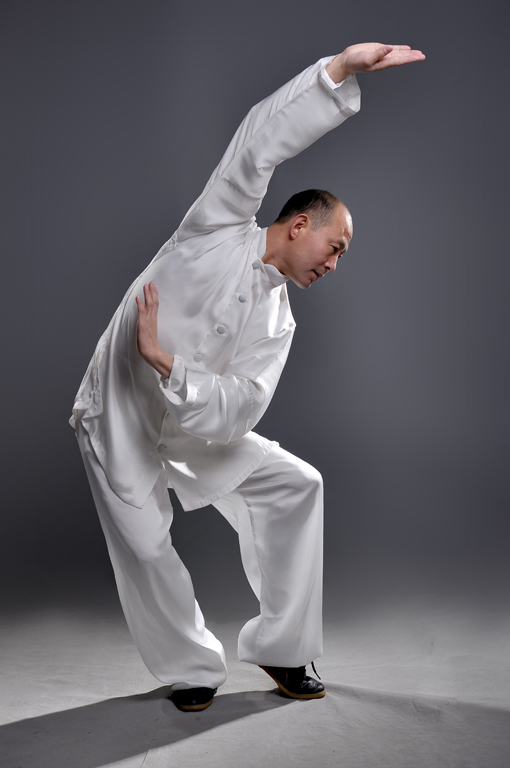
Rub Backbone (Rou Ji Shi) is Step 5 of Health Qigong ·Da Wu. The Chinese character “揉 (Rou: rubbing)” has a left radical with a meaning hands (the left part of the character means hands), with the same pronunciation of “柔 (Rou: softness)”. The rubbing, originally with a meaning of bending or straightening woods, means kneading, massaging, scrubbing and twisting backward and forward. Its interchangeable character is “柔 (Rou: softness)”, meaning rubbing up and traction. Backbone “脊 (Ji)”, originally indicating the bones down the middle back of human beings or animals, is known as back, ridge rib, chine, ridge, spine, spinal cord or spinal column, etc. Rub Backbone mainly accomplishes the dispersion and ascent, purification and descent of the lung-qi, through the side stretching and bending on the right and the left of arms and legs, led by backbone. During the left-right side stretching and bending, stretch and converge condyles, knees, backbone, shoulders, elbows and wrist from bottom to top, joint by joint, to improve the flexibility of joints and to dredge human blood and qi.
I. Movement Processes and Joint Points
Movement 1: Connect the last movement of Shake Body (Zhen Ti Shi). Move the center of gravity to the left. Draw the right foot to the inner side of the left foot. When the right foot sole settles on the ground, the feet show a T-shaped stance towards to the right. Meanwhile, swing both arms downward, towards the left and upward, successively. When the left arm swings to the same height with shoulders, the palm of the left hand downward and the fingertips towards the left. When the right arm swings to the bottom left with an angle around 45°, the fingertips of the right hand towards the left. Bend both elbows slightly, with air inhalation and eyes looking at the left hand.
Movement 2: Keep moving. The left knee remains bending with an angle around 45°. Take the sole of the right foot as the axle, driving the abduction of the right leg until the tiptoe towards the right. Meanwhile, swing the hip to the left, and bend the trunk rightward to the upper right, heeling with an angle around 45°, compared to the vertical line. Drive the left arm to swing upward and towards the right. When the arm swings to the upper right, at the angle around 45°, slightly bend the left elbow, with the palm upward and the fingertips towards the right. Move the right hand down to the left axilla. Keep the right hand at the same height with acupoints Laogong and Dabao. The two acupoints are 10 cm apart. Then, bend the right elbow and give some distance from the axilla, with air inhalation and eyes looking at the left hand. When the trunk bends rightward with an angle around 45°, turn the head to the right, with air inhalation and eyes looking at the lower right, and pause the movement a little bit.
Movement 3: Go back to Movement 1 from the ending stance of Movement 2, by following the movement processes finished earlier.
Movement 4: The right foot steps forward towards the right, and the step is a little bit wider than shoulder breadth. Move the center of gravity to the right; bend the right knee slightly; draw the left foot to the inner side of the right foot; when the left foot sole settles on the ground, the feet show a T-shaped stance. Meanwhile, swing both arms downward, towards the left and upward, successively. When the right arm swings to the same height with shoulders, put the palm of the hand downward and the fingertips towards the right. When the left arm swings to the lower right with an angle around 45°, bend both elbows slightly and put palms downward, with air inhalation and eyes looking at the right hand.
Movement 5: Same as Movement 2, only switch the directions of right and left.
Movement 6: Go back to Movement 4 from the ending stance of Movement 5, by following the processes finished earlier.
Movement 7: Same as Movement 4, only switch the directions of right and left.
Performing the whole movements, from both right and left sides, is counted as 1 set, and the movements need to be finished by doing 2 sets. Following the ending stance of the last movement in the second set, move the left foot to parallel two feet; the distance is slightly wider than shoulder breadth, with two straightened legs. Meanwhile, do lateral raise with the left arm downwards, towards the left and upwards; do lateral raise with the left arm towards the right, and bend the right elbow slightly, with the palm upwards and fingertips outward. Next, make a circle by tow arms, fingertip to fingertip; keep a distance around 10 cm between fingertips of the two hands, with palms downwards and arms shaping like arcs. Coordinate with air inhalation, with eyes to the front. Then, bend both legs with an angle around 45°. Meanwhile, conduct qi to its origin; press two palms down in front of the belly at the same height with the navel, and keep a distance from the belly around 10 cm, fingertip to fingertip, slantways. Coordinate with air inhalation, with eyes looking forward down.
(By Lei Bin)

